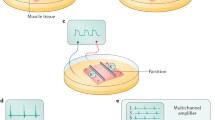Abstract
The intestinal EMG obtained from chronically implanted electrodes in canine preparations provides for the evaluation of intestinal motor activity and its control. The basic electrical rhythm (BER) and spike components on the EMG signal provide evidence of control activity and a measure of contraction intensity, respectively. A hardware system is presented in which these two components are separated by filters and the contraction spikes counted in fixed epochs to yield a contraction spike per unit time record against time. The signal is also available in parallel binary form at the end of each epoch, together with a data-ready signal for direct acquisition by computer. Tests of system performance and operating protocols are given. The preprocessor is used as a fast front end to a digital signal processing system specifically built for intestinal EMG analyses.
Similar content being viewed by others
References
Bass, P., Code, C. F. andLambers, E. H. (1961) Electrical activity of gastro-intestinal function.Am. J. Physiol.,201, 587–592.
Daniell, E. E., Carlow, D. R., Wachher, B. T., Sutherland, W. H. andBogoch, A. (1959) Electrical activity of the small intestine.Gastroenterol.,37, 268–281.
Daniell, E. E. (1975) Electrophysiology of the colon.Gut,16, 298–329.
Duthie, H. L., Brown, B. H., Robertson-Dunn, B., Kwong, N. K., Whittaker, G. E. andWaterfall, W. (1972) Electrical activity in the gastro-duodenal area: slow waves in the proximal duodenum.Am. J. Dig. Dis.,17, 344–351.
Duthie, H. L. (1974) Electrical activity of gastro-intestinal smooth muscle.Gut,15, 669–681.
Hara, Y., Kubota, M. andSzurszewski, J. H. (1986) Electrophysiology of smooth muscle of the small intestine of some mammals.J. Physiol.,372, 501–520.
Hara, Y. andSzurszewski, J. H. (1986) Effect of potassium and acetylcholine on canine intestinal smooth muscle.Ibid.,372, 521–537.
Taylor, I., Duthie, H. L., Smallwood, R. H. andLinkens, D. A. (1975) Large bowel myoelectric activity in man.Gut,16, 805–814.
Thuneberg, L., Rumessen, J. J. andMikkelson, H. B. (1982) Interstitial cells of Cajal—an intestinal impulse generation and conduction system?Scand. J. Gastroenterol.,17, Suppl. 71, 143–144.
Wood, J. D. (1975) Neurophysiology of Auerbach's plexus and control of intestinal motility.Physiol. Rev.,55, 307–324.
Author information
Authors and Affiliations
Rights and permissions
About this article
Cite this article
Challis, R.E., Richards, S.R. & Wingate, D.L. Signal preprocessing system for the small intestinal electromyogram. Med. Biol. Eng. Comput. 27, 117–124 (1989). https://doi.org/10.1007/BF02446219
Received:
Accepted:
Issue Date:
DOI: https://doi.org/10.1007/BF02446219




